Historically, predators such as wolves, mountain lions, and bears were scorned and hunted with little remorse or restraint. They have been vilified as threats to livestock, companion animals, and us. State and federal wildlife management policies continue to treat many predators as unwanted species, rarely imposing science-based or humane restrictions on their killing. Archaic attitudes advocating for the removal of predators to protect livestock and boost populations of prey species that are seen as more financially valuable—particularly deer, elk, and other ungulates—continue to hold sway.

The global slaughter of predators is unrelenting, despite a growing body of scientific literature documenting their immense value as integral species in properly functioning ecosystems. Among many benefits, predators keep prey populations from overrunning natural landscapes and croplands (and target the sick and weak, in stark contrast to trophy hunters seeking the most impressive individuals), reduce disease transmission, provide food for scavengers such as California condors and bald eagles, and keep smaller mesocarnivores (e.g., coyotes, foxes, martens, skunks) in check—thereby preventing cascading negative impacts to other species.
Globally, the decline in apex predators, whether terrestrial or marine, has had direct and indirect deleterious impacts on biodiversity and habitat. Conversely, the return of predators to native lands and waters has been a boon: In Yellowstone National Park, wolf reintroduction has changed ungulates’ use of the landscape in response to the risk of predation. The changes in elk movements, distribution, and habitat use patterns have reduced browsing pressure on cottonwood and aspen saplings, improved the health of riparian areas, and benefited multiple species. In the Pacific Ocean, the recovery of some sea otter populations has reduced urchin numbers, allowing kelp forests to recover and benefiting a diversity of species that rely on kelp as food and habitat.
The value of predators need not be described solely in terms of their positive ecological effects, however. Recent studies have endeavored to calculate their economic benefits. Historically, predators were seen as having monetary value only in terms of hunting/trapping license and pelt sales. Today, economists include nonconsumptive recreational benefits and ecosystem services in calculating predators’ role in the economy.
Bats, for example, consume massive numbers of insects that damage crops. This saves US farmers tens of billions of dollars each year, potentially, in pesticide applications alone; bats also pollinate plants, a service valued at $200 billion globally (Kasso & Balakrishnan, 2013). A single bobcat in Yellowstone has an estimated wildlife-watching value of $308,000 over a single winter season, compared to an exploitive value of $315 for a bobcat hunted or trapped in Wyoming over the same season (Elbroch et al. 2017). As for sea otters, an analysis published this year in Science estimated their value in restoring kelp forests, increasing fish production, sequestering carbon, and enhancing ecotourism at 53.6 million Canadian dollars (~40.6 million US dollars)—far more than their C$7.3 million (~US$5.5 million) cost to the marine invertebrate fishing industry (Gregr et al. 2020).
The ecological and economic value of predators demands that we discard old prejudices against these species and promote their protection. As Dr. William Ripple of Oregon State University and colleagues stated in a 2014 study, “promoting tolerance and coexistence with large carnivores is a crucial societal challenge that will ultimately determine the fate of Earth’s largest carnivores and all that depends upon them, including humans.”